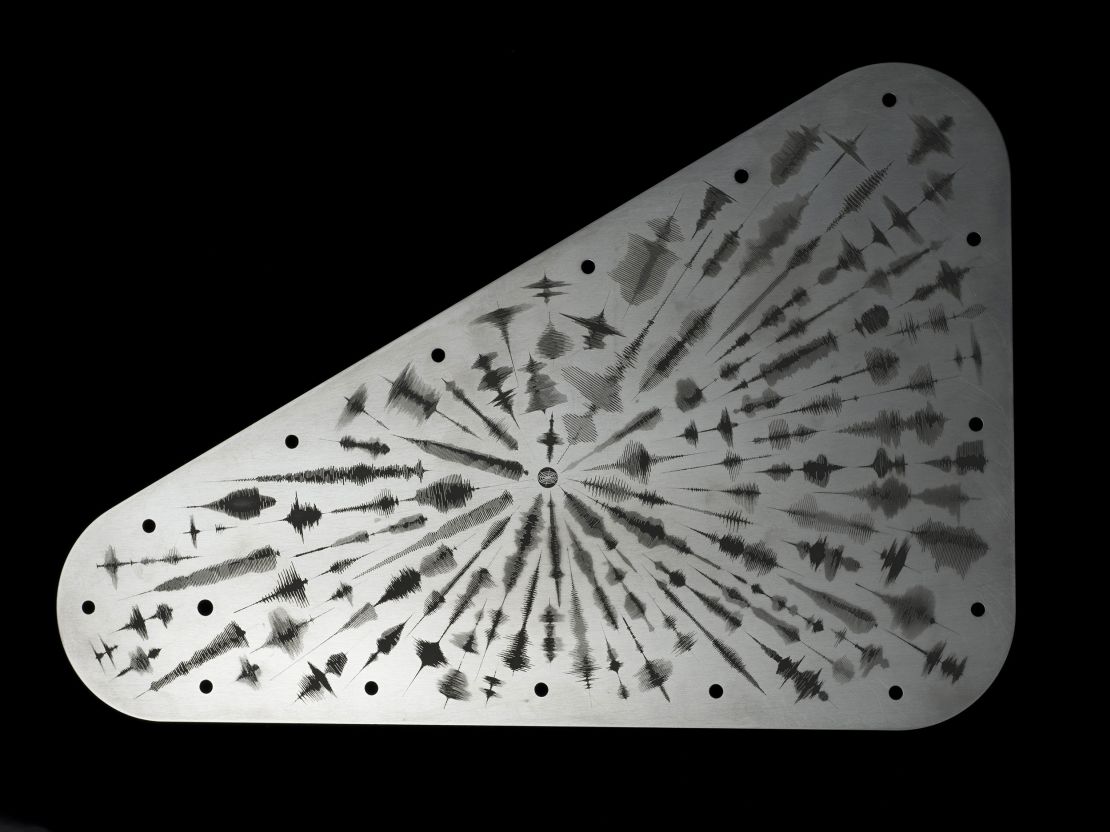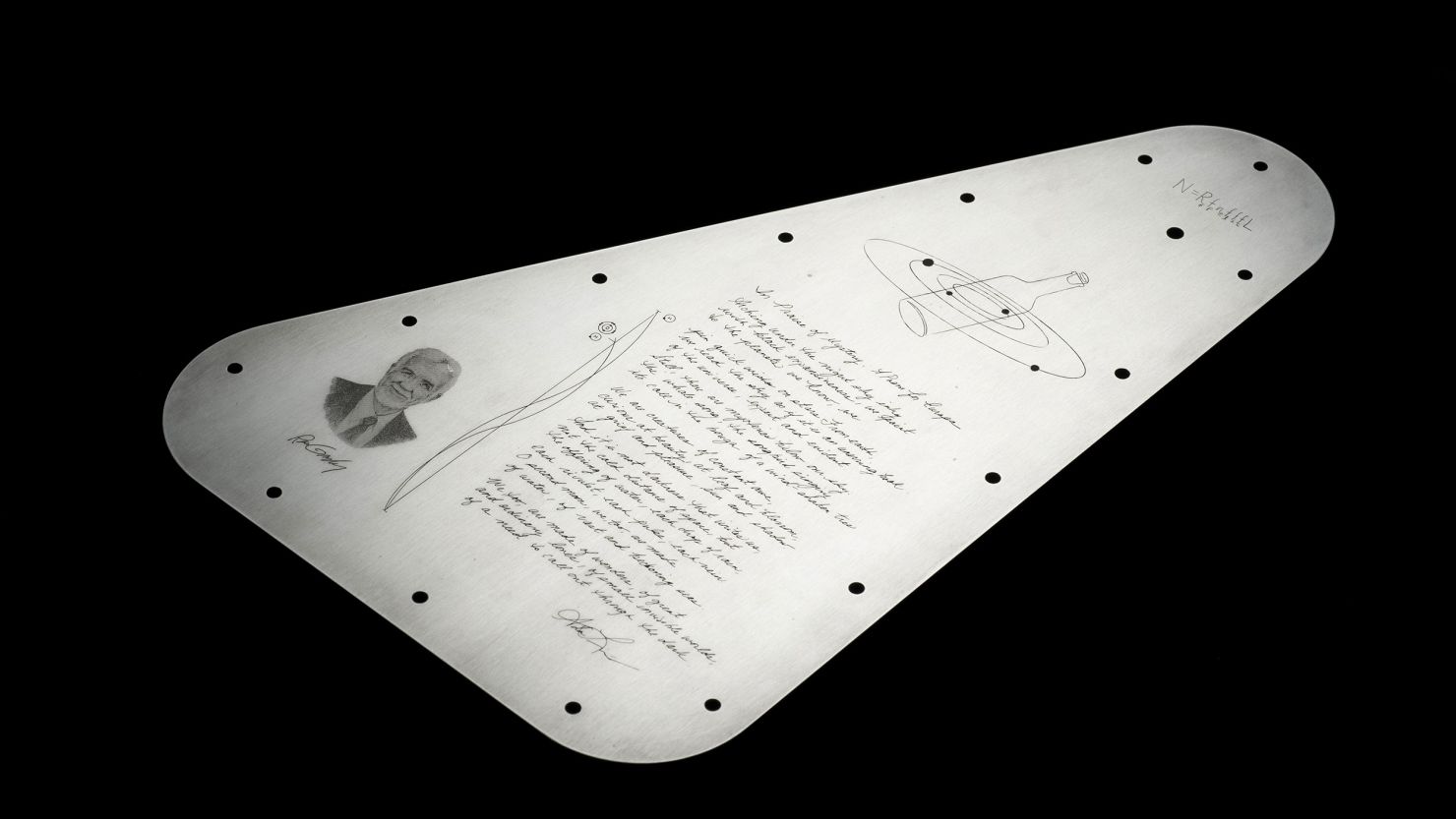Sign up for CNN’s Wonder Theory science newsletter.?Explore the universe with news on fascinating discoveries, scientific advancements and more.
When NASA’s Europa Clipper aims to launch on its highly anticipated mission to an icy moon in October, the spacecraft will carry a unique design etched with names, poetry and artwork symbolizing humanity.
The US space agency has a long history of sending names and meaningful designs aloft aboard missions, including the Voyager probes, the Perseverance rover and Parker Solar Probe. Now, it’s Europa Clipper’s turn to carry on the tradition of ferrying a design that illustrates why humans are driven to explore the cosmos.
This latest mission is headed to Jupiter’s moon Europa, one of several lunar ocean worlds considered to be the best places to search for life beyond Earth. Scientists estimate that a global ocean with more than twice the amount of water in Earth’s oceans exists beneath Europa’s thick icy shell. Earth’s oceans contain about 321 million cubic miles (1.3 billion cubic kilometers) of water, according to the National Oceanic and Atmospheric Administration.
Decorated on both sides and made of the rare metal tantalum, the triangular plate will seal the spacecraft’s sensitive electronics inside a vault to protect them from Jupiter’s harsh radiation.
On the inside of the vault is a silicon microchip stenciled with more than 2.6 million names submitted by the public. The microchip is at the center of a design that shows a bottle floating within the orbit of Jupiter and its moons to symbolize that it serves as a cosmic message in a bottle.
Technicians at NASA’s Jet Propulsion Laboratory in Pasadena, California, used electron beams to stencil the names at a size smaller than one-thousandth the width of a human hair.
Below the bottle, the design features the original poem “In Praise of Mystery: A Poem for Europa” by US Poet Laureate Ada Limón, etched in her handwriting, as well as a portrait of the late planetary sciences pioneer Ron Greeley, an Arizona State University professor who played a crucial role in laying the foundation for the development of a mission to Europa.
The side of the plate facing the inside of the vault also includes an etching of the Drake Equation, developed by the late astronomer Frank Drake of the University of California Santa Cruz in 1961 to estimate the possibility of finding advanced life beyond Earth. The equation remains an important part of astrobiological research as scientists search for evidence of life beyond our planet.
The external side of the plate carries waveforms, or visual representations of sound waves, that depict the word “water” in 103 languages from around the world. At the heart of the spiral is a symbol that means “water” in American Sign Language. The audio of the spoken languages collected by linguists for NASA is available on its website.

A planetary legacy
Early NASA probes such as Pioneer 10 and Voyager have continued to inspire the artwork that travels aboard other planetary science missions.
When NASA’s twin Voyager probes lifted off to explore the solar system just weeks apart in 1977, they carried identical golden records designed as the first recorded interstellar message from humankind to potential intelligent life in the cosmos. The records had both audio and visuals that aimed to capture Earth’s diversity of life and culture, including greetings in 59 human languages and 115 images of life.
Europa Clipper’s plate was designed with that spirit in mind to honor the potential connection between the moon’s ocean and Earth’s oceans, according to NASA.
“The content and design of Europa Clipper’s vault plate are swimming with meaning,” said Lori Glaze, director of NASA’s Planetary Science Division, in a statement. “The plate combines the best humanity has to offer across the universe — science, technology, education, art and math. The message of connection through water, essential for all forms of life as we know it, perfectly illustrates Earth’s tie to this mysterious ocean world we are setting out to explore.”
After a 1.6 billion-mile (2.6 billion-kilometer) journey to Europa, Europa Clipper will spend the next few years flying by the ice-covered moon to see whether the ocean beneath it could support life. Europa Clipper is set to make nearly 50 flybys of Europa, eventually coming within 16 miles (25.7 kilometers) above its thick ice crust to survey almost the entirety of that moon.
The spacecraft will use cameras, spectrometers, ice-penetrating radar and a thermal instrument to understand how the moon formed and whether it’s possible for life to exist on icy ocean worlds.
“We’ve packed a lot of thought and inspiration into this plate design, as we have into this mission itself,” said Robert Pappalardo, project scientist at JPL, in a statement. “It’s been a decades-long journey, and we can’t wait to see what Europa Clipper shows us at this water world.”





